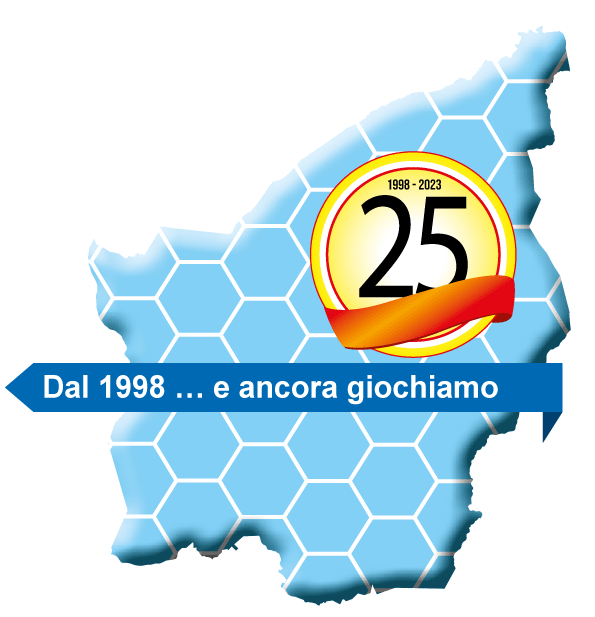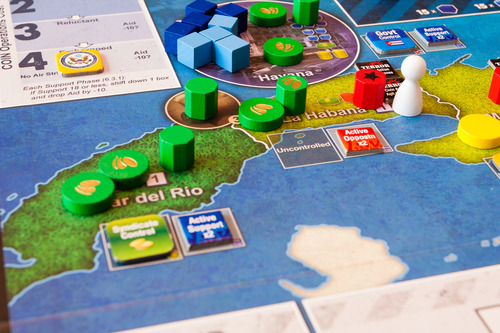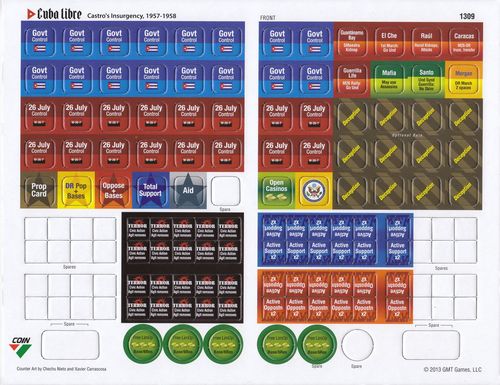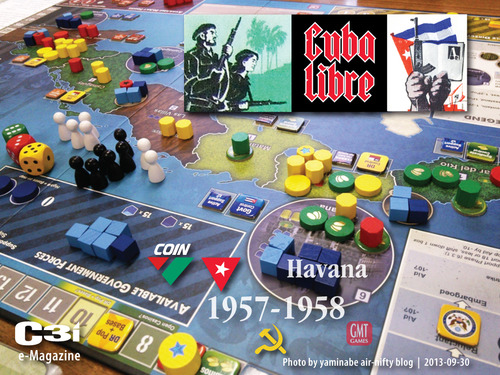|
I componenti di Cuba Libre; ottimi!
Una fase del gioco
I pochi makers necessari
|
Da Wikipedia: Con la locuzione Rivoluzione cubana si intende il rovesciamento del dittatore cubano Fulgencio Batista da parte del Movimento del 26 di luglio, spesso abbreviato in “M 26-7” e l’ascesa al potere di Fidel Castro. Il termine è anche usato per indicare il processo, ancora in atto, che tenta di costruire una società tendenzialmente egualitaria secondo i principimarxisti, messo in atto dal nuovo governo cubano dal 1959.
La presente voce enciclopedica si riferisce esclusivamente alla rivoluzione nei tardi anni cinquanta. Tutto ebbe inizio con l’assalto alla Caserma Moncada, avvenuto il 26 luglio del 1953, e fine il 1º gennaio del 1959, con la fuga di Batista da Cuba; Santa Clara e Santiago di Cubafurono prese dalla milizia popolare (Ejército Rebelde) guidata da Fidel Castro ed Ernesto Che Guevara.
Cuba Libre, Castro’s Insurgency COIN series, Volume II GMT Games Volko Ruhnke e Jeff Grossman I giochi prodotti dalla GMT definiti COIN games (COunterINsurgency Series), permettono di simulare conflitti moderni con la guerriglia come sistema base di combattimento. I titoli pubblicati, ad oggi, sono: Andean Abyss, Cuba Libre e A Distant Plain—Insurgency in Afghanistan. I prossimi titoli saranno Fire in the Lake—Insurgency in Vietnam, oltre a Bush War—The Fall of Portuguese Angola, Long Hard Slog—The Iraqi Insurgency……….. Contenuto della scatola Intanto la scatola! Coloratissima, di dimensioni “grandi”, permette di stoccare tranquillamente i materiali di gioco. Mappa Bella la mappa, di dimensioni “piccole” (circa metà di AA…..), molto colorata, rigida. L’isola di Cuba è totalmente raffigurata e suddivisa in 7 provincie, 3 città e 3 centri commerciali. Sono stampate anche le posizioni iniziali delle varie unità, dei supporti e/o delle opposizioni. Come già in AA per le città appaiono, sullo sfondo, paesaggi e/o edifici reali. Pedine In realtà poche, sono markers utili a registrare attività e situazioni in mappa. In ogni caso molto colorate e belle. Carte Le carte sono molto belle; presentano immagini, testi di Eventi e i simboli delle varie fazioni in gioco. Cuba Libre NON è un carddriven, ma un boardgame “assistito da carte”, caratteristica del sistema COIN, appunto. In pratica i giocatori non avranno più “la mano di carte” che possono usare come punti comando e/o eventi e/o altro, ma carte che stabiliscono l’ordine di gioco e la possibilità di svolgere alcuni eventi. Le carte hanno i 4 simboli delle fazioni coinvolte in maniera random per ogni carta; la posizione di tali simboli stabilisce quale fazione avrà l’iniziativa di “mossa/evento”. Se una fazione “passa” guadagna risorse e potrà giocare successivamente. Regolamento Il libretto delle rules si presenta come da elevati standard GMT: chiaro, a colori, con esempi. Solo 11 le pagine dedicate alle regole “base” e 5 quelle dedicate al gioco in solitario. Chi ha giocato ad Andean Abyss riuscirà ad affrontare Cl molto facilmente, dato che le differenze infatti sono minime: i centri economici che in pratica rimpiazzano le linee di comunicazione del titolo precedente; la fazione governativa, che non ottiene benefit duraturi se non per la mano in corso fino alla carta propaganda; l’attività di infiltrazione, tipica dei guerriglieri di Castro; il controllo su province e/o città, importante ai fini di vittoria di alcune fazioni; i Casinò del Syndicate, vere e proprie miniere d’oro; infine, nel gioco solitario, è possibile giocare con qualsiasi fazione e non solo quella governativa. Le regole in realtà sono semplici; la vera sfida, nel sistema COIN, è quella di capire cosa dover fare per raggiungere gli obiettivi di vittoria delle singole fazioni. CL, per le sue dimensioni “geografiche” permette di concentrasi molto di più su tale aspetto del sistema asimmetrico creato da Runke. Consiglio di studiare bene la regola 2.3.7 e guardare l’immagine appena sotto la stessa! Utili anche gli esempi di gioco a pagina 6 del Play Book. Tabelle Ottime e complete le tabelle di gioco; cuore della simulazione le tabelle riferite alle COIN Operations e Special Activities. Playbook Veramente uno “stato dell’arte” il playbook. espansivo, a colori, completo di esempi, tutorial, note del progettista e storiche. Suggersisco, per i possessori di AA di leggere subito la pag. 14 che elenca in dettaglio le differenze da quel titolo. Le note relative a “Role Summaries” sono fondamentali, per tutti. Prime impressioni Ottima simulazione! Se vi è piaciuto Andean Abyss, Cuba Libre sarà un must!! Più gestibile nelle dimensioni e possibilità di gioco, permette di concentrarsi sulle quattro diverse strategie di gioco specifiche di Governo, Direttorio, Sindacato, Movimento 26 luglio. Il periodo simulato è, perlomeno per il sottoscritto, più “conosciuto”; su Castro, Che Guevara e la rivoluzione di Cuba si possono trovare ottimi articoli on line e anche vari libri. Più facile, quindi, capire il soggetto del gioco; io ho suggerito (vedi sotto) anche l’uso di alcune “pedine leaders” che potrebbero dare più colore alla simulazione. Svolgimento del gioco: Ad ogni “turno”, i giocatori avranno un proprio segnalino posizionato sulla tabella denominata Elegible. In ogni momento vengono scoperte 2 carte di gioco che presentano, nella parte alta, una sequenza di priorità per le 4 fazioni. La prima fazione a sinistra e di seguito le altre potranno: eseguire un’operazione, un evento e anche un’attività speciale, oppure passare. Se viene pescata una carta “Propaganda” si controllano le condizioni di vittoria, si aggiornano le risorse e si esegue un reset. Dopo la quarta carta propaganda la partita termina. Le attività sono leggermente diversa per ognuna delle fazioni; da qui il carattere “asimmetrico” del sistema COIN. Per apprezzare e giocare al meglio il sistema di Runke, infatti, è necessario innanzitutto riuscire a gestire bene le varie Operazioni e Attività speciali, caratteristiche di ogni fazione. Capire, poi, come “costruire” lo sviluppo delle proprie forze per vincere il gioco! Il mazzo di carte, di “sole” 40 ogni partita, permette di completare il gioco in tempi relativamente brevi. In definitiva un ottimo acquisto! Vedi anche: http://boardgamegeek.com/thread/1051777/cuba-libre-coin-at-its-best per una bella recensione e discussione su BGG!
Dopo alcune partite, con 4 giocatori e anche in solitario, ho avuto uno scambio di idee con l’autore del sistema, Volko Runke; gentilissimo, ha risposto con solerzia e in accordo con lui ho deciso di pubblicare le mails che ci siamo scambiati. 12 Ottobre, Hello Volko. I have just received from GMT the games Cuba Libre and Distant Plain. Great games, good materials, high standard as always by the GMT. Next month we will publish a review of CL ASGS on our website, see: www.asgs.sm I write to highlight, from boardwargames enthusiast for over 30 years, a feeling that I had already experienced playing at Andean Abyss: the difficulty of entering the period of the game; the difficulty of being able to say to play with a historical simulation. The players are concentrated to such an extent in managing asymmetric system who do not experience the story that the game should simulate. For my part I have almost the feeling of playing an abstract theme where > only changes the geographic scenario. – When I play Labirynth, even if it is a true carddriven, I feel simulate the story. I play the story. The cards portray characters and events that have a weight in the game. The system works, elegant, historic. – When I play to Andean Abyss and now Cuba Libre, I feel just the historic > period. The characters and events have a limited impact on the system. Actions defined Operations and Activities are not connected to the historic event. I do not know, the game system I like, I repeat, but it remains a bit of disappointment for the aseptto town. I’m wrong? I have to try Distant Plain and looking forward to the title on Vietnam. I hope, however, that the games will be more …… simulation! Gian Carlo Ceccoli Presidente A.S.G.S. www.asgs.sm
Hello Giancarlo! Terrific to hear from you! I don’t think it’s a “right” or “wrong”. Every player responds to gaming experiences differently (like art, eh?). I have the opposite reaction: I feel in Labyrinth much more that I am playing cards from my hand, which first, and so on. In COIN, I feel that I am pursuing an insurgent campaign or a counterinsurgency, developing my position. Both are rough “simulations”, but I myself feel the simulation more in COIN. It will be interesting to see how A Distant Plain and Cuba Libre strike you compared to Andean Abyss. Best regards always, Volko
14 Ottobre, Hello Volko . Interesting discussion , I believe. I repeat, the COIN system is great but, given the topics I think it’s important not to miss a golden opportunity : to have a historical simulation with a new system evolved from CardDriven ……….. I give an example: – The victory of the revolutionaries was due to several factors , including the massive desertions in the army of Batista . Probably this factor is re- defined by the Special Activities Infiltrate , but it is not highlighted ! Perhaps it would be better to think of historical place notes that explain each action? – Castro organized military campaigns in advancing group called ” columns ” . At the command of the same were Che Guevara and Camilo Cienfuengos . Difficult to say that the game allows players to simulate this situation . Today , I played a second game in solitary, and in this case I have to admit that CL is easier to manage than AA . In week I will try ADP . P.S. With regard to the next title , Fire in the lake – Vietnam , I think it’s very, very important to the historical aspect . The Vietnam will sell many, many boxes of GMT , especially in the U.S. , so it should be at the top . GC
Thanks GC, glad you are continuing to try it! Yes, interesting discussion, thank you for responding! Re Columns, the game system distinguishes moving groups of guerrillas, for example for Activation after March. But I disagree with you that the columns were a deciding factor in Castro’s victory. I think they were incidental, helpful at the operational-tactical level but not the core of Castro’s genius. Castro’s winning genius was political: it was to unite the anti-Batista forces behind him and coordinate them into a revolution. This political level is Cuba Libre’s focus, and I believe the game simulates it quite well, organically in fact, in the interactions of the players (or, solo, among the player and the Nonplayer bots). For Fire in the Lake, I know that the game will encounter many different receptions and opinions among players as to the history and what it should have included or left out (it already is from testers and from folks who have never played it!). Co-designer Mark Herman’s knowledge of Vietnam Wr history is deep and insightful (the main reason I so wished to do a Vietnam game with him). There is a ton of history and simulation in Fire in the Lake — from Mark, me, and others at GMT — much to debate and for players to tell us we got wrong! Best regards, Volko
|
| Links interessanti
http://boardgamegeek.com/thread/1051777/cuba-libre-coin-at-its-best http://boardgamegeek.com/filepage/96018/cuba-libre-concetti-di-gioco |
|
| € 60,00 | GMT games |
Novembre 2013: Cuba Libre





